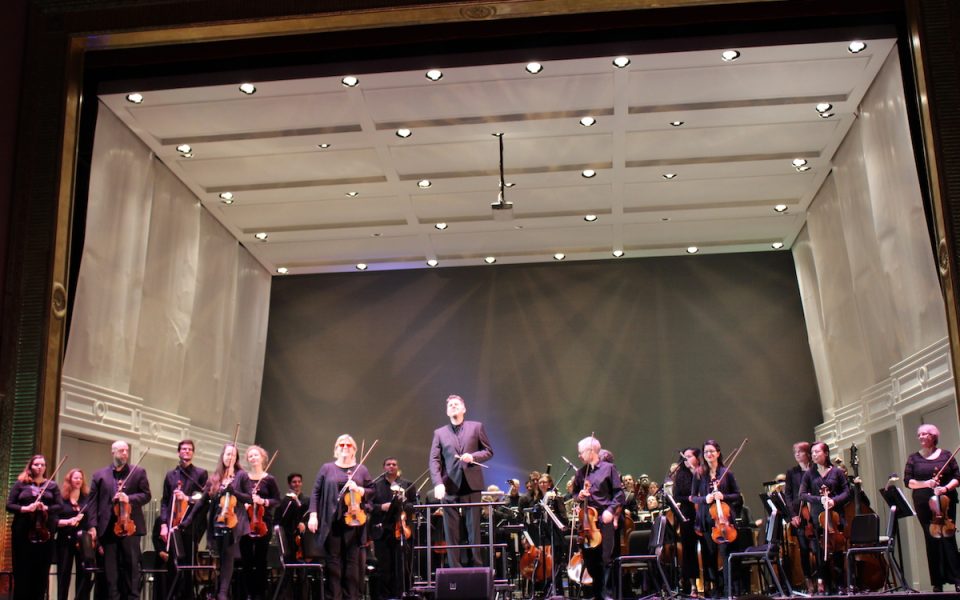The golden outline of a curvy sans-serif font spelling out
the words “Star Wars” flashes onto the screen. Almost simultaneously, the brash
blare of brass instruments resonates through the theater and penetrates the
earbuds of every viewing member. It’s triumphant; it’s optimistic; it’s Star
Wars.
Since 1977, American composer John Williams has created the
musical score for every single Star Wars film, including the most recent
and final film of the story arc, Rise of Skywalker. And despite new
characters, planets, creatures and storylines, each film begins with the same
memorable tune. It elicits an almost Pavlovian response from viewers, a sense
of excitement and nostalgia that swells in their chests.
On Sunday afternoon, the Winston-Salem Symphony aimed to
evoke those same feelings by playing a concert dedicated to many of Williams’
most famous pieces of music. The 88-year-old is widely regarded as one of the
greatest film composers of all time, and currently holds the record for the
most Oscar nominations for a living person. Only Walt Disney has more. The
concert, which played to a crowd of adults and dozens of enthusiastic children,
took place at the R. J.
Reynolds Memorial Auditorium.
“He’s changed the way we experience film,” says Travis Creed, the general manager of the symphony. “I think there’s built-in nostalgia with this music that’s built into the popular ethos. It’s built into our heads. Everybody will have a moment in the show where they have a visceral moment.”
Indeed, it’s hard to imagine 20th Century film
without the work of Williams, who scored some of the most successful and
memorable films in the modern era including Jaws, the Jurassic Park
franchise, the Indiana Jones franchise, Superman, the first three Harry
Potter films and Schindler’s List to name a few.
But the opening song played during Sunday’s concert wasn’t a
piece that made it onto the big screen. Instead it was something that rallied
the world’s best athletes during the 1984 Summer Olympics. Now recognized as
one of the most famous Olympic themes, alongside Leo Arnaud’s “Bugler’s Dream,”
Williams’ “Olympic Fanfare and Theme” opens again with a distinct brass section
led by a group of repeating trumpets that builds into a crescendo and lands
into the steady beating of a reserved snare drum. According to an interview on
johnwilliams.org, Williams said he created the music to express each of the
athletes’ enormous efforts during the games.
“It
is difficult to describe how I feel about these athletes and their performances
without sounding pretentious, but their struggle ennobles all of us,” Williams
says. “I hope I express that in this piece.”
During
the concert, conductor Timothy Redmond repeatedly spoke about Williams’ genius
and ability to convey the depths of human emotion so acutely and universally
through his compositions. Before the performance of “Flight to Neverland” from Hook,
Redmond noted that “John Williams adds pixie dust like no one else.”
According
to Creed, concerts that showcase Williams’ music often sell out and are usually
played as part of symphonies’ “Pops” concerts, but he says that audience
members should know that the music is just as difficult as pieces by giants
like Mozart or Beethoven.
“It is real classical music,” Creed says. “It is technically very difficult. We actually have extra rehearsals because of the complexity of these pieces.”
Throughout
the evening, the skilled musicians play score after score from film after film,
until they arrive at the set of music that many in the audience, especially
those of younger ages, have been waiting for.
A single
high-pitched, whimsical melody begins playing on the celesta, an instrument
that looks like a piano but sounds closer to a xylophone. The chaotic swirls of
minor violins join in as the wind instruments introduce a mysterious melody.
“Hedwig’s
Theme” from Harry Potter and the Sorcerer’s Stone is like many of
Williams’ pieces in that it acts as a leitmotif, or a recurring theme, in a
piece of music that’s associated with a particular person or situation. In
fact, it’s exactly this kind of writing that Williams used for much of his music
for Star Wars.
“Imperial March” which was first introduced in The Empire
Strikes Back, has become a kind of calling card for Darth Vader. In the
film, the score plays in the background Vader’s looming Executor comes into
focus. A from-behind shot captures the back of Darth Vader’s head, his hard
breathing heard over the aggressive blares of trumpet and trombone. For the
rest of the series, any time Vader or his empire enters a storyline, the same
ominous theme can be heard.
On Sunday afternoon, Vader makes an appearance in person.
Accompanied by Boba Fett and a decked-out stormtrooper, he
marches authoritatively onto the stage, his fist raised in triumphant glory.
Kids who are getting sleepy and slouching in their seats suddenly perk upright,
craning their necks to get a closer look. And that’s the magic of Williams’
creations, Creed says.
“His music really hits home with people,” he says. “You
don’t have to be a classical music lover to love this show.”
To learn more about the Winston-Salem Symphony, visit wssymphony.org.
Join the First Amendment Society, a membership that goes directly to funding TCB‘s newsroom.
We believe that reporting can save the world.
The TCB First Amendment Society recognizes the vital role of a free, unfettered press with a bundling of local experiences designed to build community, and unique engagements with our newsroom that will help you understand, and shape, local journalism’s critical role in uplifting the people in our cities.
All revenue goes directly into the newsroom as reporters’ salaries and freelance commissions.


Leave a Reply